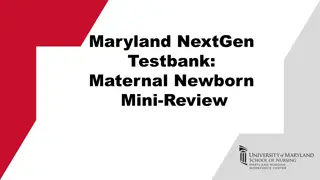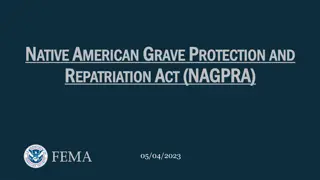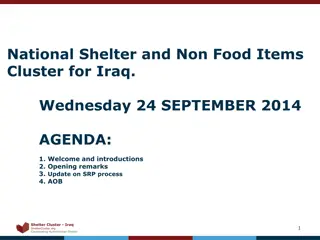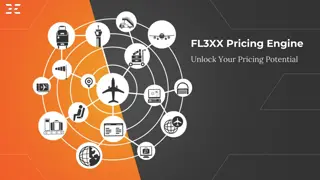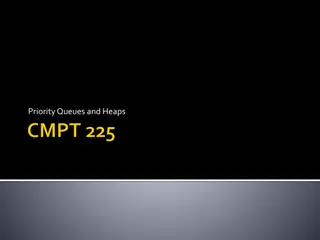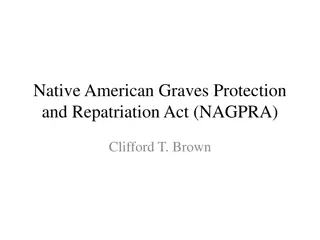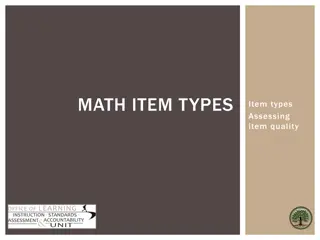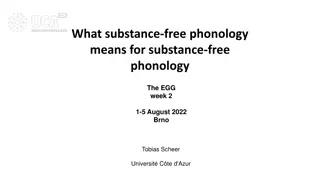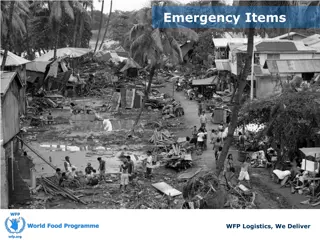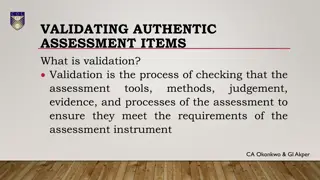Programmatic items
The programmatic items for the INFCOM-3 Information Session include considerations of WMO Programmes relevant to the Commission, work programmes for the next intersessional period, and subsidiary bodies. Highlighted is the draft Recommendation 5/1 on the Expanded World Weather Watch Programme and the Space Programme, emphasizing the need for an evolved program structure. Resolution 62 from the Congress reviews and streamlines program elements, maintaining the World Weather Watch Programme and the Space Programme while requesting the Infrastructure Commission to develop expanded descriptions. The Executive Council is to receive the updated programme descriptions at its 78th session in June 2024. Additionally, SERCOM has adopted Recommendation 5.1/1 on Weather, Climate, Hydrological, Marine, and Related Environmental Services Programme.
Download Presentation

Please find below an Image/Link to download the presentation.
The content on the website is provided AS IS for your information and personal use only. It may not be sold, licensed, or shared on other websites without obtaining consent from the author.If you encounter any issues during the download, it is possible that the publisher has removed the file from their server.
You are allowed to download the files provided on this website for personal or commercial use, subject to the condition that they are used lawfully. All files are the property of their respective owners.
The content on the website is provided AS IS for your information and personal use only. It may not be sold, licensed, or shared on other websites without obtaining consent from the author.
E N D
Presentation Transcript
Programmatic items Pre INFCOM-3 Information Session (25 March - 5 April 2024) J. Hasegawa/Secretariat 26 March 2024
Content 1. Agenda item 5, Doc 5: consideration of the WMO Programmes relevant to the Commission 2. Agenda item 6.1, Doc 6.1: work programme for the next intersessional period 3. Agenda item 6.2, Doc 6.2: subsidiary bodies for the next intersessional period 4. Q&A Documents are available in the Work in Progress section of the INFCOM-3 website, until Draft 1 is published.
1. Consideration of the WMO Programmes relevant to the Commission Doc 5, INF 5
WMO Programmes Doc 5 Doc 5: draft Recommendation 5/1 - Expanded World Weather Watch Programme and its affiliated programme (the Space Programme) to recommend the new programme description to be considered by the Technical Coordination Committee and adopted by the Executive Council. Responding to: Resolution 42 (Cg-19) Technical commissions and additional bodies Resolution 62 (Cg-19) Review of previous resolutions Resolution 7 (EC-77) Subsidiary bodies of the Executive Council
WMO Programmes Doc 5 In Resolution 62 (Cg-19), Congress reviewed and streamlined the foundational elements of the WMO programme structure and decided, (a) to maintain the World Weather Watch Programme, including components on the WMO Integrated Global Observing System, WMO Information System, WMO Integrated Processing and Prediction System and consolidating the Instruments and Methods of Observation Programme and requested the Infrastructure Commission to develop an expanded programme as an evolution of the World Weather Watch Programme, encompassing the infrastructure needs to cover the entire Earth system; and (b) to maintain the Space Programme, to coordinate, together with space agencies, the activities of Members to ensure sustained and interoperable satellite observations, enhance capacity building and to promote satellite products and applications and requested the Infrastructure Commission to develop and update the descriptions of the programmes to be maintained in light of the governance reform, the Strategic Plan and other intervening changes. INFCOM is requested to submit the programme descriptions to the Executive Council at its 78th session (June 2024) SERCOM has adopted Recommendation 5.1/1 (SERCOM-3) - Weather, Climate, Hydrological, Marine and Related Environmental Services Programme
WMO Programmes Doc 5 Benefits of defining major programmes Consolidated view of planning and implementation of component systems Clear linkage between programme objective and strategy/planning documents of component systems Clear definition of roles and responsibilities of entities Members, technical commissions, research board, regional associations and the Secretariat Alignment of WMO Convention purposes, long-term goals, bodies, major programmes and the Secretariat structure Tool for communication and relationship with United Nations, other specialized agencies, communities of interest and experts
Programme-related responsibilities of the five organs established by Art. 4(a) of the Convention Establishment of scientific and technical programmes (GR 154(2)) Congress Coordinate and organize Members activities related to the planning, implementation and evaluation of agreed programmes, strategies and activities; Identify requirements among Members and regional bodies and communicate them, together with anyimpediments to the timely implementation of planned programmes and activities, to the technical commissions; (GR II) Coordination of programmes and utilization of resources on behalf of Congress (Conv. Art. 14) Executive Council Implementation and evaluation of the scientific and technical programme activities (GR III) Regional Associations Technical Commissions Daily programme management under the guidance of the Executive Council and in close collaboration with the technical commissions (GR 154(2)) Secretariat Independent verificationof [ ] operational activities, including programme evaluation, monitoring mechanisms [ ] (FR 13.7) 7 Internal Oversight Office Note: the role of the Research Board is currently not reflected in the General Regulations but can be assimilated to that of the technical commissions
Alignment of WMO Convention purposes, long-term goals, bodies, major programmes and Secretariat structures 2 (f) Training 2 (a) Observation networks Purpose 2 (f) Research 2 (e) Operational hydrology 2 (d) Applications of meteorology 15 (d) Technical information, counsel and assistance 2 (b) Exchange of information 18 Regional associations 2 (c) Standardization Long-term goal LTG 1 LTG 2 LTG 3 LTG 4 RAs INFCOM RB SERCOM Body EC/CDP Global Atmosphere Watch Regional Programme Major programme World Weather Research Programme Weather, Climate, Hydrological, Marine and Related Environmental Services Programme Expanded World Weather Watch Programme Capacity Development Programme World Climate Research Programme Science and Innovation Department Secretariat structure Member Services Department Services Department Infrastructure Department
Expanded WWW programme Purpose: Building on the heritage of the World Weather Watch founded in 1963 Responding to the preamble of the WMO convention and its Article 2 (a), (b), (c) and (e); The objective of the expanded WWW programme is: Development and implementation of globally coordinated component systems: the WMO Integrated Global Observing System (WIGOS), the WMO Information System (WIS) and the WMO Integrated Processing and Prediction System (WIPPS), for: Acquiring, processing, transmitting and disseminating Earth system observations, and related standards; The development and implementation of sound data and information management practices for all WMO Programmes and their associated application and services areas; The coordination of the production and use of standardized analysis and model forecast fields.
Expanded WWW programme Scope is defined in two dimensions: (1) Application areas, including their users a) Weather and weather-related applications; b) Climate, including climate services and including the contribution to and from the Global Climate Observing System (GCOS); c) Water-related applications; d) Related environmental services, specifically atmospheric composition-related applications, and space weather services. (2) Earth system domains, where the component systems are operated in/for: a) Atmosphere, both physics and chemistry (composition), b) Hydrology c) Cryosphere d) Ocean e) Terrestrial/land surface that are not covered by hydrology and cryosphere domains; f) Space weather
Expanded WWW programme Scope: (3) Emphasizing the importance of partnership with non-NMHSs entities, especially in the non-atmospheric Earth system domains. The Programme includes those activities for assisting programmes of surface and upper-air meteorological and other Earth system observations in areas of global commons: space (through the affiliated Space Programme), the High Seas, and the Antarctic, working with relevant international organizations, as well as the development and implementation of Antarctic regional practices and facilitating the exchange and dissemination of Antarctic data for operational and research purposes. (4)
Expanded WWW programme Overall objectives: Underpinned by the WMO Unified Data Policy The progrramme ensures the long-term outcomes are reached by 2030: An integrated Earth system observational network, including on hydrology, ocean, cryosphere, atmospheric composition and space weather, increasingly automated and optimized to ensure effective and sustainable global coverage; High-quality fit-for-purpose traceable measurements of all components of the Earth System, feeding a continuous free and unrestricted global data exchange in accordance with the WMO Unified Data Policy and underpinned by standardized data management and exchange mechanisms; and Increasingly more relevant, reliable, and quality assured Earth system numerical analysis and prediction products provided to enable Members to provide required services. The Programme directly addresses Strategic Objectives 2.1, 2.2 and 2.3 of the WMO Strategic Plan 2024-2027: 2.1 Optimize the acquisition of Earth system observation data through the WMO Integrated Global Observing System (WIGOS); 2.2 Improve and increase access to, exchange and management of current and past Earth system observation data and derived products through the WMO Information System (WIS); and 2.3 Enable access to and use of numerical analysis and Earth system prediction products at all temporal and spatial scales from the WMO Integrated Processing and Prediction System (WIPPS).
Component systems of the expanded World Weather Watch: the WMO Integrated Global Observing System, the WMO Information System and the WMO Integrated Processing and Prediction System (WMO global infrastructure) their interrelation and the relation with users
Programme components Programme component 1: WMO Integrated Global Observing System (WIGOS) Programme component 2: WMO Information System (WIS) Purpose and scope: responding the Convention Article 2 (b) Purpose and scope: responding the Convention Article 2 (a) and (c), with an additional dimension of surface-based (both ground and ocean) and space-based systems (coordinated through the affiliated Space Programme). Main long-term objective(s) * refer to WIS2 Strategy and IP Implementation activities By Members, INFCOM, SERCOM, RB, RAs and the Secretariat Main long-term objective(s) * refer to the WIGOS Vision 2040, the High-Level Guidance, GCOS IP, GOOS 2030 Strategy, WMO-IOC Collaborative Strategy 2022-2025, GAW SIP, Vision and Strategy for Hydrology and Associated Plan of Action Programme component 3: WMO Integrated Processing and Prediction System (WIPPS) Purpose and scope: responding the Convention Article 2 (a) and (c) Main long-term objective(s) * refer to the WIPPS collaborative framework, Vision and Strategy for Hydrology and Associated Plan of Action Implementation activities By Members, INFCOM, SERCOM, RB, RAs and the Secretariat Implementation activities By Members, INFCOM, SERCOM, RB, RAs and the Secretariat
Space Programme Purpose and scope: Together with space agencies, to ensure sustained and interoperable satellite observations, enhance capacity building and to promote satellite products and applications. It promotes wide availability and utilization of satellite data and products for all the relevant application areas and Earth system domains, and integrates all components required for the provision of operational services within the applicable WMO processes and frameworks. In particular, the WMO Space Programme coordinates the development of space-based observing system to achieve full implementation of the Vision for WMO Integrated Global Observing System in 2040 (WMO-No. 1243), recognizing the complementary nature of the space-based and surfaced-based components of WIGOS, their individual strengths and limitations, and potential for integration. Emphasizing the partnership with satellite operating agencies in CGMS and CEOS.
Space Programme Space Programme activities are in five main areas: 1. Integrated space-based observing system 2. Availability and use of satellite data and products 3. Capacity Building and User Engagement 4. Space Weather Coordination 5. Coordination for the use of radio frequency spectrum
2. Work programme of the Commission for the next inter- sessional period Doc 6.1, INF 6.1
Work programme Doc 6.1 Doc 6.1 includes draft Resolution 6.1/1 to adopt the work programme (work plan) of the Commission for the next intersessional period. Work programme consists of the list of activities and corresponding deliverables in three groups: 1) Development, maintenance and monitoring activities in 2024-2025 (e.g., update manuals and guides, compliance monitoring) 2) Specific elements/focus areas from the Strategic Plan 2024-2027 under each relevant Strategic Objective (SO) in 2024-2025 3) Explore new initiatives to be promoted in the next intersessional period (2025- 2026)
Work programme Doc 6.1 Management Group is requested to: (1) To continue to maintain, update and to regularly review and reprioritize the activities and deliverables, including the minor and moderate modifications to the activities of the WMO Plan of Action for Hydrology 2023-2030, and to submit necessary deliverables to the future sessions; (2) To review the approach taken to define the work programme and propose, if necessary, an improved approach to define and update the work programme and to monitor and evaluate its implementation, considering the programme description to be adopted, and the review of the WMO programme-based approach and related planning, programming and budgeting processes conducted by the Executive Council;
3. Subsidiary bodies of the Commission for the next inter- sessional period Doc 6.2, INF 6.2
Subsidiary bodies Doc 6.2 Doc 6.2 includes: Draft Resolution 6.2/1 to establish SCs, AGs and SGs, and coordinators Draft Decision 6.2/1 to endorse chairs of SCs, AGs and SGs, and coordinators Draft Decision 6.2/2 to endorse the composition of the Management Group
Draft Resolution 6.2/1 Decision to establish the first level groups and coordinators Standing Committee on Earth Observing Systems and Monitoring Networks (SC-ON); Standing Committee on Measurements, Instrumentation and Traceability (SC-MINT); Standing Committee on Information Management and Technology (SC-IMT); Standing Committee on the WMO Integrated Processing and Prediction System (SC-WIPPS); Study Group on Environmental Sustainability (SG-EnvS); [Doc 7.3] Study Group on Future Data Infrastructure (SG-FIT); [Doc 8.3(5)] Study Group on Centres Assessment, Designation and Compliance Review (SG-ADCR); [Doc 8.5(4)] Advisory Group on the Global Cryosphere Watch (AG-GCW); Advisory Group on the Ocean (AG-Ocean); Advisory Group on Hydrology (AG-Hydro); [Doc 8.5(3)] Advisory Group on the Global Greenhouse Gas Watch (AG-G3W); [Doc 7.2] Coordinator on the implementation of the WMO Unified Data Policy (C-DATA); Coordinator on capacity development (C-CD);
Standing Committees Working on standard setting and implementation monitoring of WIGOS, WIS and WIPPS SC-WIPPS WIPPS SC-MINT WIGOS - measurements SC-ON SC-IMT WIS Addressing requirements and engaging with community WIGOS - networks specific to Earth system domain AG-Ocean Advisory Groups AG-GCW (Global Cryosphere Watch) AG-Hydrology AG-G3W (Global Greenhouse Gas Watch) Space Weather Satellite/space agencies C-Data (implementation of the Unified Data Policy) C-CD (Capacity Development) Cg and EC requests Addressing specific Study Groups SG-EnvS (Environmental Sustainability) SG-FIT (Future Data Infrastructure) SG-ADCR (Centres Assessment, Designation and Compliance Review)
Draft Resolution 6.2/1 Requests to the president on follow-up actions: Selection of experts and establishment of Expert Teams and Task Teams Appointment of representatives and focal points on SERCOM, RB, JCB and the EC panels and inform Members Outstanding items to be tasked to the president: Working and coordination structure/mechanism for space weather activities guided by the Four- year Plan for WMO Activities related to Space Weather 2024-2027 [Doc 8.5(2)] Working structure for coordination of satellite related activities and for engagement with partner space agencies through CGMS and CEOS [Doc 9.1] Working structure for development of a WMO Standard Vocabulary Working structure for collaborating with SERCOM and UNESCO on guidance materials in the hydrology domain Governance of AG-Ocean: to more effectively represent and advise infrastructure-related bodies under JCB
Draft Decision 6.2/1 Decision to endorse chairs and vice-chairs of standing committees, study groups and advisory groups and coordinators Standing Committee on Earth Observing Systems and Monitoring Networks (SC-ON); Standing Committee on Measurements, Instrumentation and Traceability (SC-MINT); Standing Committee on Information Management and Technology (SC-IMT); Standing Committee on the WMO Integrated Processing and Prediction System (SC-WIPPS); Study Group on Environmental Sustainability (SG-EnvS); Study Group on Future Data Infrastructure (SG-FIT) Study Group on Centres Assessment, Designation and Compliance Review (SG-ADCR); Advisory Group on the Global Cryosphere Watch (AG-GCW); Advisory Group on the Ocean (AG-Ocean); Advisory Group on Hydrology (AG-Hydro); Advisory Group on the Global Greenhouse Gas Watch (AG-G3W); Coordinator on the implementation of the WMO Unified Data Policy (C-DATA); Coordinator on capacity development (C-CD);
Draft Decision 6.2/1 process PRs and experts are invited to make nomination of candidates of chairs and vice-chairs of standing committees, study groups and advisory groups. Through the circular letter: 01543/2024/I/Technical Experts The proposal will be made by the elected officers (president and vice-presidents), to the plenary session of Day 5, for the Commission s decision, based on the above nominations. Information on the nomination is available on the INFCOM-3 website - INFCOM-3 - Selection of chairs of subsidiary bodies (wmo.int) Note: Election will be only for officers; c.f. Doc 12
Draft Decision 6.2/2 Decision to endorse the composition of the Management Group of the Commission for the next intersessional period a) Elected officers: president and up to three co-vice-president(s), b) Chair, co-chairs, vice-chair, co-vice-chairs of the standing committees, study groups and advisory groups [decided through draft Decision 6.2/1], c) Coordinators on Capacity Development and the implementation of the WMO Unified Data Policy, d) One representative from each of the six regional associations Working Groups/Committees on Infrastructure (if not already included under (b) and (c) above) based on agreement between the president of each regional association and the president, e) Chair of the Steering Committee of GCOS, as an ex-officio member, f) Chair of the Steering Committee of GOOS, as an ex-officio member, g) Representative of CGMS, as an ex-officio member; INFCOM leaders Coordination on cross- systems topics Collaboration with Regions Partner engagement Note: ToR of the Management Group is defined in Annex III of the RoP-TC (WMO-NO. 1240)
Thank you. Questions welcome! wmo.int





